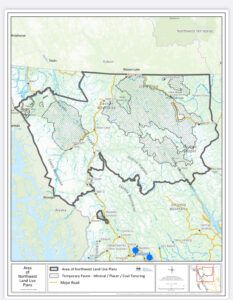- within Transport and Tax topic(s)
- with Senior Company Executives, HR and Finance and Tax Executives
- in Canada
- with readers working within the Accounting & Consultancy, Banking & Credit and Insurance industries
On June 3, 2025 the BC government announced it is "kicking off land-use planning in the northwestern corner of B.C"1. The area affected is approximately 16 million hectares (larger than the provinces of New Brunswick, Nova Scotia and Prince Edward island combined) and includes some of the most significant existing and potential mineral exploration areas in BC.
The planning process does not presently have any legislative basis, but the government has established joint websites with the Tahltan (Project Details – Land Use Planning) and Taku River Tlingit First Nations related to each area. The process is being described as an "expedited" one, taking place over the next year.
The government has also issued an order under the Environment and Land Use Act (ELUA) restricting staking of new mineral claims and issuing coal licenses within approximately 5 million hectares of the total affected area.

Implications for Industry
- Short-Term Uncertainty
Although the ELUA order does not formally restrict permitting on existing tenures, companies may face practical delays or increased scrutiny in obtaining or amending exploration permits during the 12-month planning period.
- Long-Term Risk of Restricted Access
In its media release, the government refers to the process "clearly identifying areas where critical minerals may be developed..." and "defin[ing] what can occur on the land base...."2
This could obviously affect areas currently open to lawful exploration and development, reducing long term access.
- Potential for Compensation Claims
If exploration or mining activities are ultimately restricted, companies may be required to seek compensation. Government officials have already indicated (in discussion with industry) that the no-staking restriction is partly intended to limit future compensation obligations.
Strategic Considerations
- Participation in the Planning Process:
Industry stakeholders are invited to engage in the planning process. However, participation should be carefully evaluated with legal counsel to ensure that it does not inadvertently weaken future compensation claims.
Consideration should also be given to potential government defence positions (which we have seen in other cases) suggesting that the company should have known potential risks associated with Indigenous land claims. It is possible similar arguments could eventually be advanced here, seeking to rely on the "notice" this land use planning exercise itself provides.
- Preserving Legal Rights:
It will be important to develop a legal strategy to protect potential compensation claims. This may include:
- Submitting formal statements to government regarding participation.
- Requesting written assurances on government positions.
- Filing access to information requests under the Freedom of Information and Protection of Privacy Act.
- Creating a formal record of engagement and concerns.
Next Steps
Companies with interests in the 16 million hectare planning area should:
- Consult legal counsel immediately to assess risks and develop a tailored engagement strategy.
- Document all communications and positions taken during the planning process.
- Monitor government actions closely, particularly any shifts in permitting practices or public statements regarding land use designations.
- Engage strategically, balancing the opportunity to influence outcomes with the need to preserve legal rights.
While not all companies will be adversely affected, the absence of government assurances and the scale of the planning area mean that all stakeholders should prepare for a range of outcomes.
Footnotes
1. News Release.
2. Ibid.
The foregoing provides only an overview and does not constitute legal advice. Readers are cautioned against making any decisions based on this material alone. Rather, specific legal advice should be obtained.
© McMillan LLP 2025






